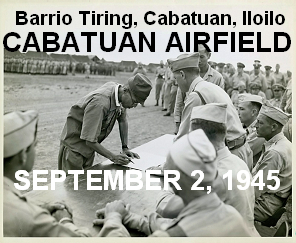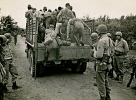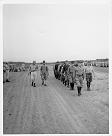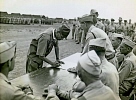






Col. Ryoichi Tozuka signs the surrender instrument
as Col. Raymond G. Stanton looks on.
Cabatuan Airfield
Barrio Tiring, Cabatuan, Iloilo
Panay Island, Philippines, September 2, 1945
|
|
- o -
|
4.2 Start of the Joint Punitive Expeditions in Panay (July 7 to December 31, 1943)
In June 1943, a new staff officer, Lieutenant Colonel Hidemi Watanabe, was assigned to the Visayas garrison headquarters at Cebu. On his way from Tokyo, he passed by Manila headquarters for general instructions on the subjugation of the Visayas area. The garrison headquarters staff was rigorously instructed to crush the Panay guerrillas completely. This was due to the latter’s attack on and the resulting humiliation of General Tanaka.
Soon after his arrival in Cebu, Colonel Watanabe came to Panay for inspection. Colonel Watanabe chose Captain Kengo Watanabe, a highly regarded officer among the staff, as his right-hand man. Immediately, the colonel asked the captain to plan the great punitive expedition in Panay. Garrison commander General Kano left everything about the plan to staff officer Colonel Hidemi Watanabe. In like manner, unit commander Colonel Tozuka put everything in the hands of Captain Watanabe who was the battalion’s Operations and Intelligence chief. Henceforth, the two Watanabes decided on the plans for and carried out the operations of the punitive expedition.
The rainy season had started when, on July 7, the Japanese forces in Panay jointly pursued a six-month punitive expedition. The forces consisted of seven companies chosen from various units, accompanied by kempeis: the Tozuka unit in Iloilo, the Kinoshita unit in Capiz, and the Taga unit in Antique. In addition, the navy gunboat Karatsu, a radio location section, and a landing craft unit from Army Headquarters in Manila were dispatched. The goals of the expedition were the capture of guerrilla leaders, their 15 wireless radios, and the destruction of their bases.
To directly command the operations, Major General Kano and staff officer Colonel Watanabe moved the expedition headquarters from Cebu City to Iloilo City. Colonel Watanabe was inclined to adopt the strategy of competitive operations and usually assigned favorable areas to Captain Watanabe. Hence, there was an apparent competition in the punitive operations between our unit, the Tozuka unit in Iloilo province in the east, and the Taga unit in Antique province in the west.
However, soon after the start of the expedition, we received a distressing warning order from Iloilo Headquarters. About 50 soldiers of the Kinoshita unit were blown up in two trucks at Dumarao, Capiz province.
Our first target was the assault of Governor Tomas Confesor’s base to capture him and destroy his position. Our punitive forces under Captain Watanabe first attacked the guerrilla base in the jungle northwest off Alimodian, around 22 kilometers northwest of Iloilo City. Nonetheless, the three companies of guerrillas who were there had already evacuated. All the houses were vacant and there was scarcely any inhabitant.
Chasing after the guerrillas, the force arrived at Cagay on their quick advance into Bocari where the civil government of Governor Confesor had its main base. A captured local resident guided us into Bocari. It was an astonishing sight to see. There were mountains surrounding Mt. Inaman (1,350 meters high), the inside basin of which was four kilometers east to west and two or three kilometers from north to south, with a roaring river flowing through the center. On the slopes were rice fields and under the trees were hundreds of houses of the villagers. We checked on the houses but they were all empty. Every day, we interrogated a dozen local residents as well as guerrillas to get information about Confesor, but there was no information forthcoming at all. Nor was there any official of the civil government to be found.
In the mountains, we found and chased down a Filipino family of three. The man killed himself with his pistol; his wife also died of exhaustion and the shock of her husband’s death. We also came across a boy of seven or eight years, from whose story we learned that his father was an important staff member of the Confesor government. Warrant Officer (WO) Fusataro Shin of the Kempeitai sympathized and took the boy with him all throughout the expedition while other soldiers took care of him as well.
During the expedition, we pushed on day and night, covered with mud and sweat. In the end, we had to give up the Bocari operation. We only learned that Confesor had developed some disease of neuralgia or some sort and that he had been carried away in the direction of Antique? We had no news about the printer of their banknotes, Press One. (Later on, we learned that the guerrillas had destroyed the printer of the civil government because of conflicts over financial matters.)
This mission did not produce much direct results. However, the inspections of the heavenly natural fort of Bocari – with its fields of rice, corn, sweet potatoes and other food sources surrounded by mountains – gave us information that would later on be useful for the retreat of the Japanese Army when the US forces on landed Panay towards the end of the war.
|
|